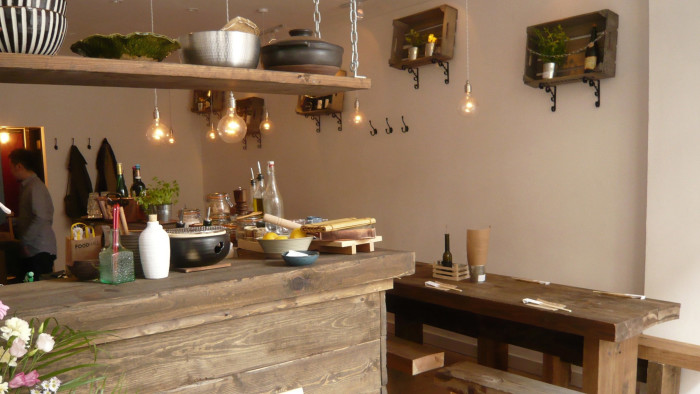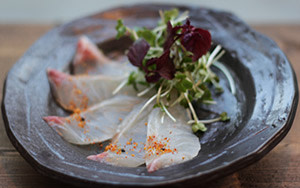Kirazu, Antidote, London

Roula Khalaf, Editor of the FT, selects her favourite stories in this weekly newsletter.
Freshness in a dish is an unquantifiable quality, but it’s one that I seem to crave more and more – and not just in the summer months. Japanese cooking, and then the pioneers of California cuisine, first alerted me to this sensation: that more can be done with less. The recent popularity of food from the Middle East, Peru and Scandinavia seems to be part of this movement, too. Itamar Srulovich, from London’s Honey & Co, explained at a recent panel debate that his only regular import from his native Israel is, surprisingly, coriander; the British version does not add the zing he is looking for.
Freshness was the common feature of two dinners in central London. The first was at Antidote, run by a largely French team but with an English chef, Chris Johns, under Swedish guidance from Mikael Jonsson of Hedone. The frontage on to the cobbled road of Newburgh Street close to Oxford Circus gives it a rather Parisian air. The second was at Kirazu in Soho, just north of the theatres on Shaftesbury Avenue, run by Yuya Kikuchi, with the simple wooden interior designed by his wife, Sakiko.
Kikuchi was a semi-professional football player in Tokyo before he came to England 17 years ago, inspired by his enthusiasm for Triumph motorcycles and the designer, Paul Smith. He turned to cooking and worked his way up the ranks of three Japanese restaurants in the capital (he is also licensed to prepare fugu, the potentially lethal blowfish) before deciding to open his vision of the cafés/restaurants he so admires in Osaka.
The Kikuchis’ determination reminded me very strongly of how Jad Youssef and Aga Ilska opened the original Yalla Yalla nearby and how Srulovich and his wife, Sarit Packer, created Honey & Co. But Kirazu is even smaller. It is no more than 500 sq ft, comprising just 25 seats and a tiny passageway behind the counter along which Kikuchi scurries as he fulfils the roles of chef and dishwasher.
But because the distance between the kitchen and the customer is no more than a couple of yards, Kikuchi can offer a long menu, plus a range of what he calls “seasonal tapas” from a blackboard. When we ate there all the dishes were excitingly fresh but the highlights were tuna, scallop and salmon sashimi served in a razor clam; octopus carpaccio in a spicy marinade with salmon roe; prawn tempura; chicken teriyaki wrapped in a pancake; and a bowl of simmered bamboo and seaweed. And because this is effectively a one-man show, prices are very reasonable.

Antidote’s charms are broader perhaps, as is the list of individuals who have brought this corner site (formerly La Trouvaille) back to life. The irrepressible Thierry Bouteloup, who has worked as general manager here for the past 13 years, was joined last year by new backers, all French but ranging from a wine importer, who have invested in a smart redesign. They in turn wanted to serve the bread that Mikael Jonsson bakes in the basement of his widely acclaimed restaurant, Hedone in west London. But Jonsson was initially reluctant because he felt that the food in Newburgh Street was then not the equal of his crumb. The French asked Jonsson to be their consultant and chef Johns was installed.
Johns faces a physical challenge common to many chefs in that his kitchen is in the basement but here there is no lift either. While this is less of a problem for the ground-floor, which offers charcuterie, cheeses and tartines incorporating Jonsson’s excellent bread, every dish for the restaurant on the first floor has to be “run up” by speedy young men who, perhaps not surprisingly, rarely last long in their role.
Freshness here came in two forms. The first was via a trio of memorable dishes: a cube of slow-cooked pork belly enlivened by San Marzano tomatoes and a mixture of fresh and sautéed endives; a breast, heart and leg of duck cleverly offset by miso-glazed courgettes; and two thick, pale slices of Cornish turbot enhanced by a topping of thin slices of gooseberries and very white fresh almonds. The second was an appetising bottle of 2010 Faustine red made by Abbatucci in Ajaccio, Corsica, which was correctly, and appropriately, served cool.
With this style of food and wine, and the breeze blowing through open windows, it was just about possible to imagine the Mediterranean outside.
——————————————-
Kirazu
47 Rupert Street, London W1D 7PD; 020 7494 2248; kirazu.co.uk
Antidote
12A Newburgh Street, London W1F 7RR; 020 7287 8488; antidotewinebar.com
Comments